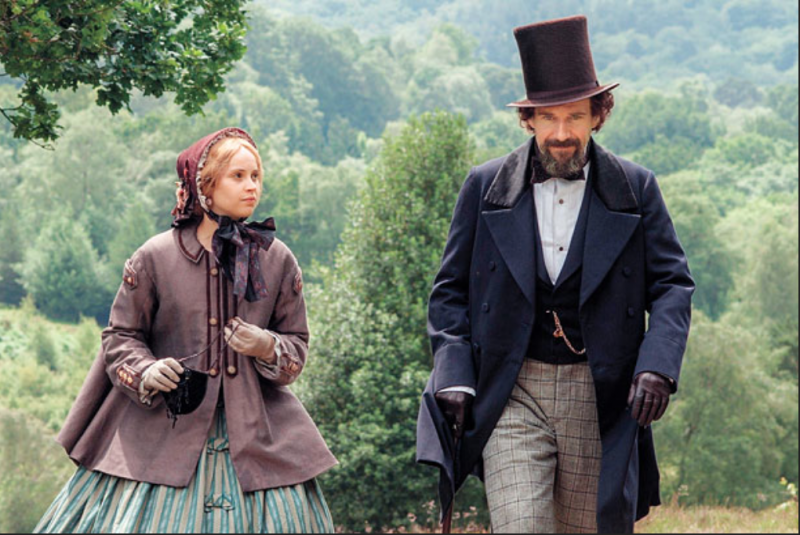Film Review: "The Invisible Woman"

“The Invisible Woman” opens with a dramatic sweeping beach scene. These striking seaside scenes- moments for Nelly’s solitary retreat- break up the chapters of the film, and are arguably the most beautiful scenes in the film. “The Invisible Woman” traces the relationship between Charles Dickens and his young muse and later mistress, Nelly.
Ralph Fiennes plays the swami that was Charles Dickens, surrounded by fans, actors and admirers. Fiennes is convincing as an unapologetically focused and driven playwright, brilliant in ways and ignorant in others. He regards his wife, mistress and groupies around him as accessories to his existence. Everyone is secondary to his work, reputation and craft.
Largely overshadowed throughout her life, it is the life story and perspective of Nelly (played by Felicity Jones) that drives the film.
Nelly is an academic of Dickens' work and enthralled by his talent. His wife, conversely, describes his art as purely a source of entertainment, to which Nelly challenges, “It changes us”. She is first brought to Dickens by her mother, an eager stage mother admittedly “anxious for her daughters’ futures”. She sets up her home as a place for her daughters to entertain Dickens, acting at times like a madam, knowingly pushing her teenage daughter toward a much older, and married man.
In an ironic scene, she confronts a young prostitute on the street asking, “Where is your mother”. It’s a foil for the role she plays with her daughters as a well groomed, lace-gloved pageant mother.
Dickens’ wife, Catherine (played by Joanna Scanlan) is a devoted wife and mother to their children. Her rotund physique and matronly manner underscore the lack of attraction between the married couple. There is no visible affection between husband and wife. In one terribly sad scene, he accidentally walks into the bedroom as she is undressing. It is an awkward moment for both and equally for the audience who can only feel for this woman.
Arguably for his own pride, Dickens hides his relationship with Nelly, defending his wife till the end. Nelly in turn becomes more and more invisible, though still used for physical intimacy. She is a casualty of his narcissism, and survives much personal heartache as a result- not excluding a raw and disturbing medical emergency.
The relationship between Dickens and Nelly was hard to decipher for the first hour of the film. It was unclear when they became intimate and what their courtship truly entailed.
What was clear was that he played a father-like role in her life. Later in the film we learn that her father was, unsurprisingly was an actor himself.
Inarguably, Dickens created at least two tortured women, though ultimately neither is ruined.
While they are still intertwined, Dickens wants what Nelly has- freedom. Once she has moved on and found her own life and marriage however, she’s never able to fully escape him. Though perhaps that’s OK. Dickens’ plays were always priceless works of art to her. She valued his literary craft even despite his harsh treatment of her and heartaches experienced as his lover.
Though his relationship with Catherine is platonic and avoidant- he does protect her and stand by their marital union.
The memories and timeline of the film are at times vague. And while the micro view into Dickens’ world is well established, a more concrete establishment of the historical context would have benefitted this film.
Dickens is depicted as a hands-on director, laying on the stage and acting in his own plays. His actors are visibly smitten with him; his audiences captivated with his word. The live stage performance scenes were vivid and highly enjoyable. It was in these moments his genius became larger than life.
Unless you have a penchant for dowdy clothing, the period costumes will make you grateful you avoided this era of fashion atrocities. Ugly dresses, dreary colors, fabrics and heinous hairstyles comprise the film’s costuming portfolio. The theatre scenes brighten up the fashion with warm stage lights and powdered wigs.
By the end of the film, it’s unclear to me what Dickens gave Nelly other than momentary praise. Though perhaps that’s the nature of torrid love affairs: the adoration you gain is temporary; and the memories wander your mind for eternity.
“The Invisible Woman” is rated PG-13.
Reach Arts and Culture Editor Ashley Riegle by email. Follow her on Twitter here.



